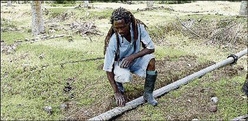Weighty woes burden children - Worry over students as they pack on the pounds
Published: Wednesday | May 27, 2009

Colin 'Buck' Wade works on connecting a pipe that will provide water to the Copper Road and Montpelier communities in St James on Monday as Jamaicans islandwide participated in Labour Day projects. - Photo by Hope Evans
Imagine weighing more than 140 pounds at age 10. Well, that's the life of a grade five student at a primary school in St Catherine.
Pauline Jackson is to grappling with the ballooning weight of her son, who wears extra large shirts and size 34 pants.
What angers her most is the embarrassment the preteen faces.
"I took him to the store and he tried several pants and they didn't fit and the store clerk responded rudely in front of his face so I won't do it (taking him with her to the store) again," she told The Gleaner.
Like many parents who battle with kids who are wooed by their sweet tooth and love for fried or fatty food, Jackson has had a hard time monitoring her son's diet when he's not under her supervision.
"I tried to put him on a strict diet at home but he does otherwise at school," she lamented.
That seems to be the popular refrain of a sorrowful tune sung by Jamaican parents and guardians of both prepubescent and adolescent children.
Sharmaine Edwards, director of the Nutrition Unit at the Ministry of Health (MOH), said obesity in children is a growing problem. She said diet and lifestyle factors such as high levels of low activity, or absolute inactivity, are the primary factors that local research has identified for the phenomenon.
Sweet and fats
She pointed out that the 2008 Healthy Lifestyle Survey indicated that Jamaicans consume 50 per cent more fat than is recommended. Forty per cent of them are either inactive or indulge in low levels of physical activity and unhealthy food choices, the study revealed.
The director added that the 2005 Youth Risk and Resiliency Behaviour Survey showed that 90 per cent of adolescents in this cohort consumed excessive proportions of sweetened beverages.
The head of the Nutrition Unit said nutrient and meal standards have been developed for use in schools to help combat preteen obesity and overweight.
"Nutrition forms part of the Health and Family Life Education Curriculum. In addition, the MOH and Ministry of Education have joint committees to review nutrition and physical activity programmes in schools," she informed.
However, there are no sanctions against schools that breach the nutrition rules. In the meantime, the Ministry of Education's Nutrition Unit has prepared school guidelines for primary schools for their lunch programmes.
Elizabeth McLean, who is in charge of the school-feeding programme at the Nutrition Unit at the Ministry of Education, said the Caribbean Food and Nutrition Institute had compiled operational manuals with recipes for the schools, but financial constraints have hampered progress.
"They are not able to keep up with these recipes. They use them as a guide but not as a hard-and-fast rule," she said.
"It's not a compelling thing because we don't have the finance to give them to do it."
nadisha.hunter@gleanerjm.com








